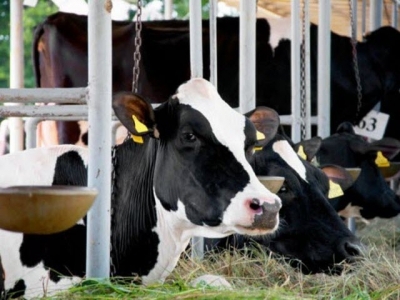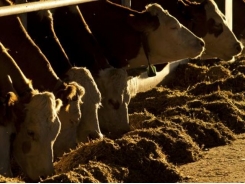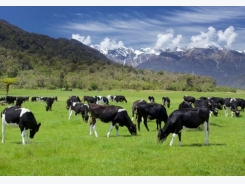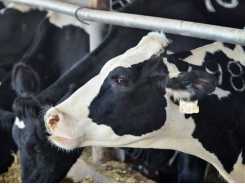Can garlic oil reduce calf greenhouse gas emissions?

Garlic oil may offer a way to reduce cow gas emissions when used with a high concentrate diet, say researchers.
A team of international researchers from Mexico, Kenya and Egypt tracked the influence feed additives on the gas production of dairy calves on a concentrate diet.
The group published their results in the Journal of Cleaner Production.
“The present experiment aimed to investigate the effect of natural feed additives i.e. garlic oil, xylanase enzyme and yeast at different levels on in vitro biogases production from 60-d old dairy calves fed a high concentrate diet,” said members of the research team.
The group found that the garlic oil generated the strongest response. However, researchers also said that more research needs to be done with the feed additives, especially in in vivo trials.
“Garlic oil, yeast, and xylanase at different levels did not affect the extents of GP [gas production]; however, garlic oil increased the rate of digestion and the lag phase,” they said. “It can be concluded that garlic oil followed by yeast and then xylanase can be used to mitigate in vitro CH4 and CO2 production from dairy calves fed a high concentrate diet.”
Why supplementation?
Ruminant nutritionists work to influence ruminal microbial ecosystems and the fermentation process to improve actions like feed utilization and feed conversion, said the researchers.
Feed additives like phytogenic extracts, enzymes and yeasts can help reduce energy loss in methane (CH4) and nitrogen (N) production, they said. Reducing methane production, without reducing feed conversion efficiency, in ruminants is of particular interest.
“The livestock production sector is one of the largest contributors of anthropogenic sources of greenhouse gases (GHG), where livestock production accounts approximately for two-thirds of the direct emissions,” said the researchers. “Methane is the most important GHG since it accounts for about 50–60% of emitted GHG; it is also responsible for a loss of about 2–12% of gross energy of feed in ruminant production systems.”
In previous research, garlic has been found to have a positive influence on digestion along with antimicrobial activity when added to ruminant feed, they said.
It has been noted to limit the amount of short chain fatty acids, amount of acetate and improve proportions of propionate and butyrate, they said. But it also has antimicrobial activity, which may impede ruminal fermentation.
“However, the mechanism by which garlic decreases CH4 production is not known; although the mechanism could be related to the capacity of organosulfur compounds to inhibit the enzyme 3-hydroxy-3-methylglutaryl coenzyme A reductase by a thiol-disulfide exchange reaction,” they said.
Use of fiber-degrading enzymes as feed additives may improve feed use and animal performance, said the researchers. And, yeast can be legally used in the US as a feed additive to prevent microflora disorders and stabilize fermentation in the rumen.
It also can modify fermentation, they said. “Yeast could enhance fungal colonization of plant cell walls resulting in increased dry matter (DM) and neutral detergent fiber (NDF) digestion and mitigate CH4 production due to stimulation of the acetogens to compete or co-metabolize hydrogen (H2) with methanogens, thereby reducing CH4 emissions,” they added.
However, little or no research has been done to examine the use of natural feed additives on the in vitro fermentation of feed using rumen inoculum from calves, said the researchers. Or examined the biogases produces from dairy calves.
Methods and materials
In the experiment, the rumen fluid from six, weaned, 60-day old calves fed on a high concentrate diet were collected for use as an inoculum source, said the researchers.
The collected rumen fluid was mixed with garlic oil at 30, 120, 250 and 500 μL/g dry matter (DM), xylanase was added at 3 and 6 μL/g DM, yeast at 2 and 4 mg/g DM and non-supplemented rumen fluid was used as a control, they said. Three runs were done for three weeks.
Samples were mixed, sealed and added to a water bath at 39 degrees C, they said. Gas production (GP) volume was noted at 2, 4, 6, 8, 10, 12, 14, 16, 18, 24, 36, 48, 60 and 72 hours post incubation and concentrations of CH4 and CO2 were measured.
Solution residue was examined to check for apparent DM degradability (DMD), they added.
Results
Garlic oil interactions produced the most response on both digestibility and CH4 and CO2 production, said the researchers.
“It can be concluded that garlic oil followed by yeast and then xylanase can be used to mitigate in vitro CH4 and CO2 production from dairy calves fed a high concentrate diet,” they said.
Garlic oil reduced the in vitro DM digestibility in a linear manner, they said. However, xylanase and yeast had no influence on degradability.
“Rate of GP were similar among different treatment at different levels,” said the researchers. “However, the rate of digestion was highest at 120 μL garlic oil and intermediate in all other treatments.”
The oil also was found to reduce methane and carbon dioxide production in a quadratic manner, they said. “The control treatment had the highest CH4 and CO2 production followed by xylanase, yeast and garlic oil,” they added.
However, as amounts of xylanase and yeast were increased in the diet, the amount of CO2 produced rose, they said.
Related news
Tools

Phối trộn thức ăn chăn nuôi

Pha dung dịch thủy canh

Định mức cho tôm ăn

Phối trộn phân bón NPK

Xác định tỷ lệ tôm sống

Chuyển đổi đơn vị phân bón

Xác định công suất sục khí

Chuyển đổi đơn vị tôm

Tính diện tích nhà kính

Tính thể tích ao




 Limited diets with high DDGs inclusion support growth,…
Limited diets with high DDGs inclusion support growth,…  Make sense of forage analysis results
Make sense of forage analysis results